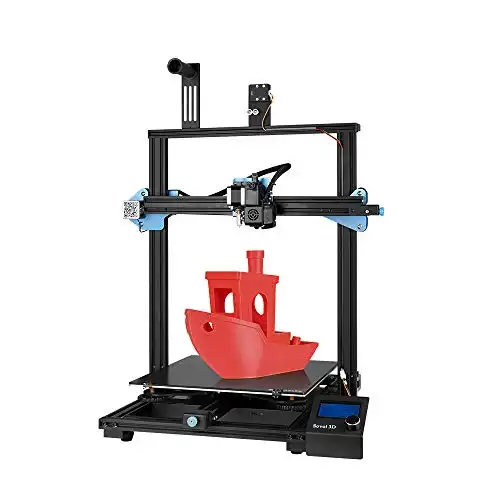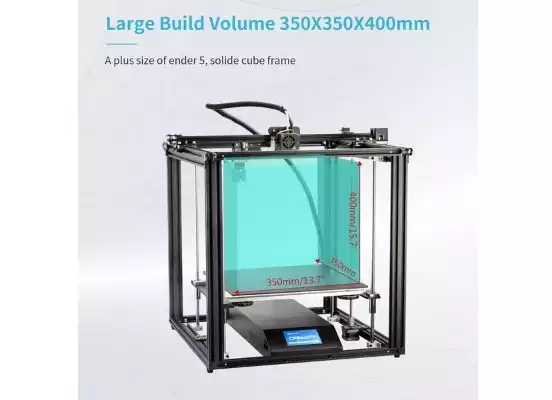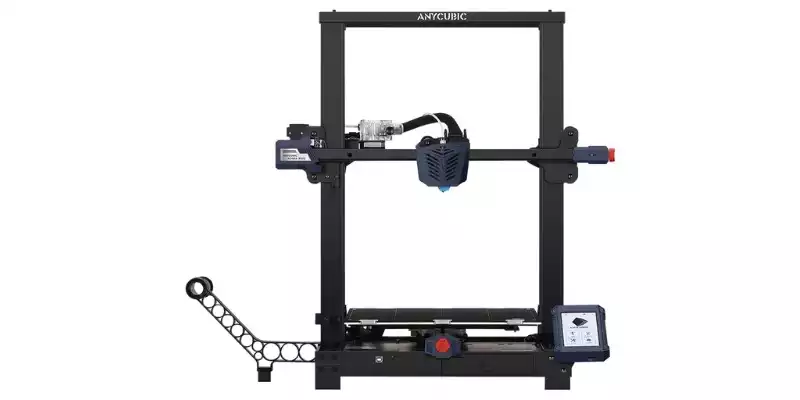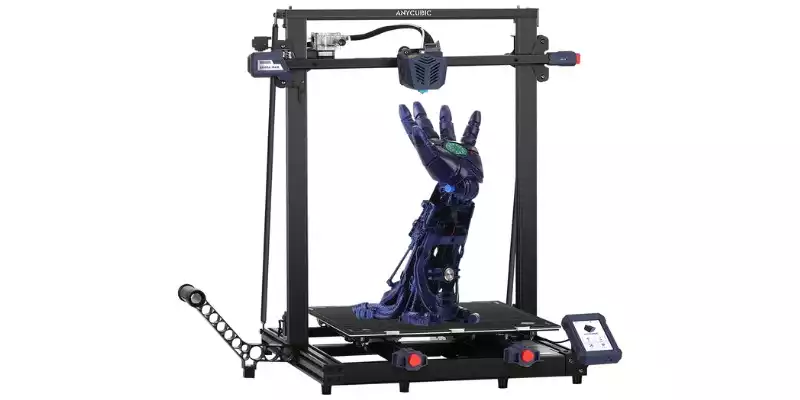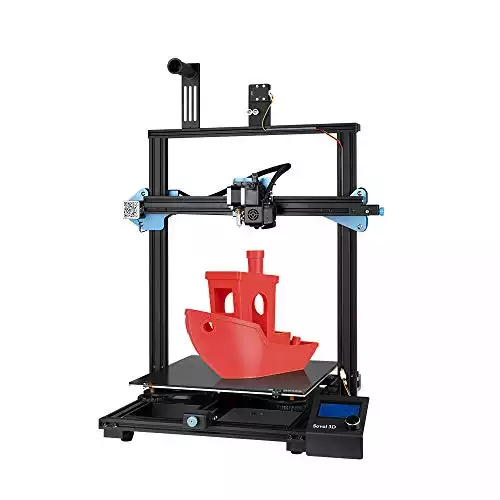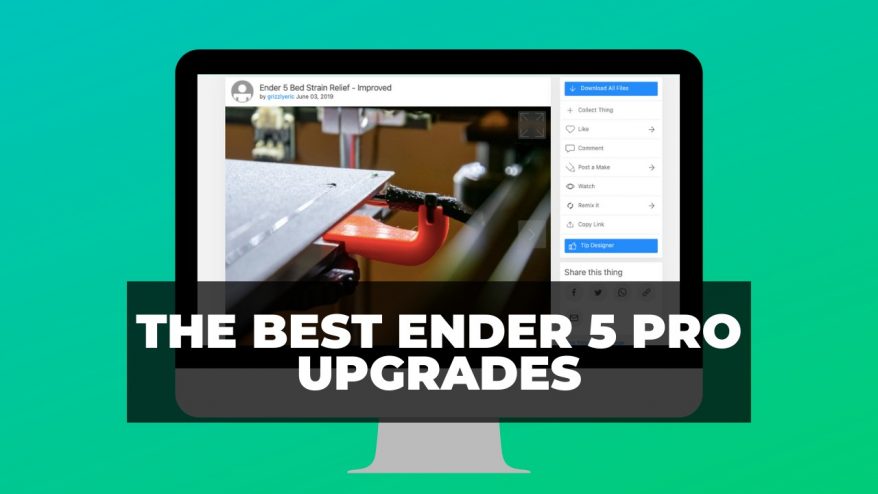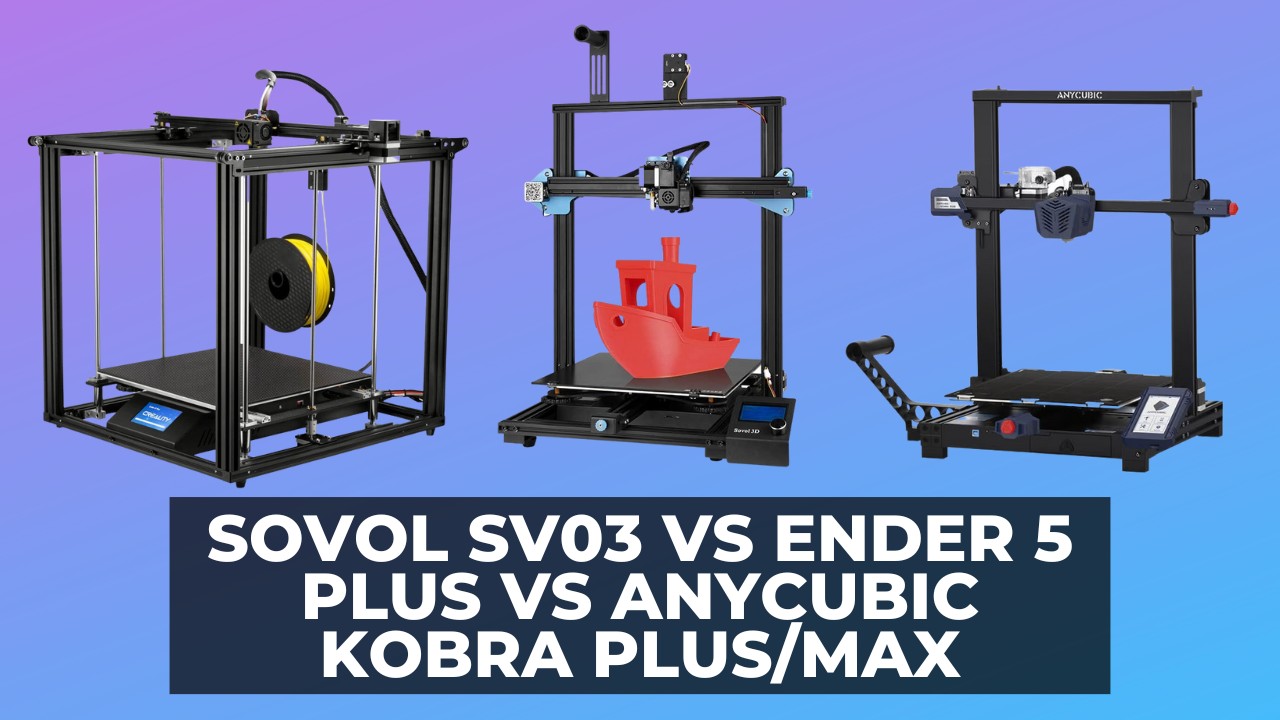
A bigger build volume doesn’t have to break the bank, and popular FDM printers like the Sovol SV03, Ender 5 Plus, Kobra Plus, and Kobra Max prove you can get a large-volume 3D printer for well under a thousand dollars.
But as nice as it is to have these options, it’s definitely a chore to try and filter through them. We’ll be covering the main selling points of each printer, including the all-important build volume as well as cost, quality of life features, and filament compatibility.
|
|
|
|
|
|
N/A
|
$580
|
$500
|
$570
|
|
Build Volume:
350 x 350 x 400 mm
|
Build Volume:
350 x 350 x 400 mm
|
Build Volume:
350 x 300 x 300 mm
|
Build Volume:
400 x 400 x 450 mm
|
|
Build Plate:
Tempered glass
|
Build Plate:
Tempered glass
|
Build Plate:
Carborundum glass
|
Build Plate:
Carborundum glass
|
|
Extruder Type:
Direct Drive
|
Extruder Type:
Bowden
|
Extruder Type:
Bowden
|
Extruder Type:
Bowden
|
|
Filament Compatibility:
PLA, PETG, ABS, TPU, and Wood
|
Filament Compatibility:
PLA, PETG, ABS, TPU, and Wood
|
Filament Compatibility:
PLA, PETG, ABS, TPU, and Wood
|
Filament Compatibility:
PLA, PETG, ABS, TPU, and Wood
|
|
Max extruder temp:
260°C
|
Max extruder temp:
260°C
|
Max extruder temp:
260°C
|
Max extruder temp:
260°C
|
|
Max bed temp:
100°C
|
Max bed temp:
100°C
|
Max bed temp:
100°C
|
Max bed temp:
90°C
|
|
Auto bed-leveling:
Yes
|
Auto bed-leveling:
Yes
|
Auto bed-leveling:
Yes
|
Auto bed-leveling:
Yes
|
|
Touchscreen:
No
|
Touchscreen:
Yes
|
Touchscreen:
Yes
|
Touchscreen:
Yes
|
|
Connectivity:
SD Card, USB
|
Connectivity:
SD Card, USB
|
Connectivity:
Micro SD
|
Connectivity:
Micro SD
|
|
|
Plus, we’ll review what prints you can make on each printer based on the build volume and filaments you can access.
Let’s get started.
SV03 vs Ender 5 Plus vs Kobra Plus/Max: A Quick Summary
Sovol SV03
- Price: Check latest price at Amazon here
- Build volume: 350 x 350 x 400 mm
- Filament compatibility: PLA, PETG, ABS, TPU, and Wood
- Layer height: 100 – 400 microns
- Printing accuracy: ± 0.1 mm
- Max extruder temp: 260°C
- Max bed temp: 100°C
- Connectivity: SD Card, USB
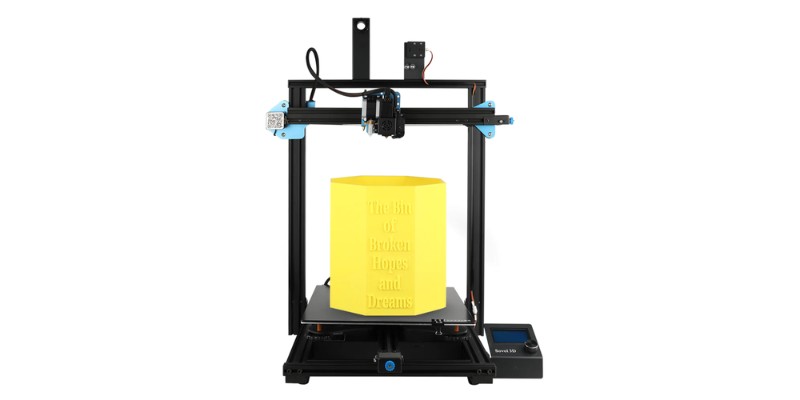
Sovol 3D isn’t a ‘household name’ like Creality or Anycubic, but their budget FDM printers can compete just fine. The Sovol SV03 is no exception: for $400, you get a large build volume of 350 x 350 x 400 mm.
You’d usually expect this price and build volume to come with advanced features, but the SV03 is still equipped with a filament sensor and auto bed-leveling through BLTouch.
It lacks a touchscreen, sticking with the rotary knob typical of cheaper printers. Thankfully, Sovol doesn’t skimp on anything else, though. The TMC2208 motherboard keeps printing relatively quiet, and the SV03 has a belt tensioner for easy maintenance.
The SV03 has no special capacity for fancy filaments, but it can print PLA, PETG, ABS, TPU, and Wood with relative ease.
The maximum extruder temperature is 260°C, the direct drive extruder simplifies extruder-related issues, and the tempered glass build plate can withstand all of the aforementioned filaments. With upgrades to the nozzle, you’d likely be able to use even more filaments.
Overall, the SV03 is a top runner for a large (but budget) 3D printer. It offers a low price but keeps the most essential features.
Ender 5 Plus
- Price: Check latest price at Creality here / Amazon here
- Build volume: 350 x 350 x 400 mm
- Filament compatibility: PLA, PETG, ABS, TPU, and Wood
- Layer height: 100 – 400 microns
- Printing accuracy: ± 0.1 mm
- Max extruder temp: 260°C
- Max bed temp: 100°C
- Connectivity: SD Card, USB
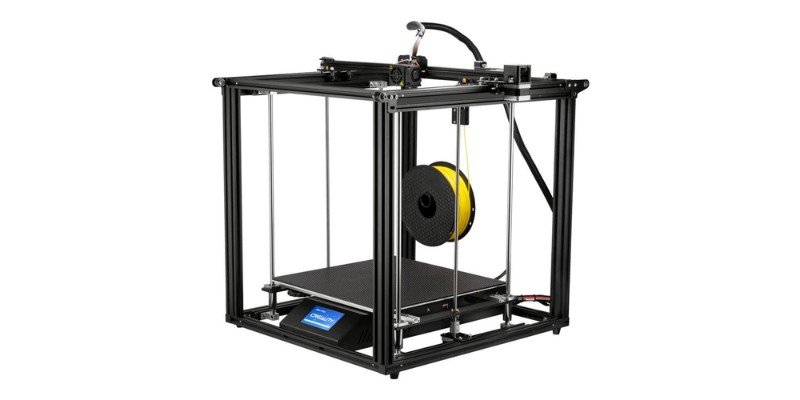
When you’re looking for budget FDM printers, Creality is a good place to check first – even if you don’t buy a Creality printer, they often have their finger on the pulse of discount printers. The Ender 5 Plus, although more expensive than most Enders, lives up to that.
It’s actually priced higher than the other printers we’re covering here, and it has the quality to match. The 5 Plus has a touchscreen, auto-leveling through BLTouch (not CRTouch, interestingly), and a filament runout sensor.
Not to be confused with the Ender 5 Pro, the Plus’s motherboard is quite loud. You wouldn’t want to set up this printer in a living space. Even aside from that, the Ender 5 Plus is easiest to use when it has plenty of space to call its own: the footprint is 632 x 666 x 619 mm, and the frame includes the spool and power supply.
Out of the overall footprint, the actual build volume is 350 x 350 x 400 mm. This places it at the exact same size as the Sovol SV03, which is no surprise since they’re made to compete with each other.
It has a maximum extruder temperature of 260°C and a bed temperature of 100°C. These specs (and the lack of upgraded extruder parts) mean that the Plus 5 can handle filaments like PLA, PETG, ABS, TPU, and gentler woods.
Other prominent features include a sturdy dual-shaft motor, an immobile bed, and a tempered glass build plate. Overall, the Ender 5 Plus has great functionality and reasonable specs for the price. If you can afford it, you won’t be disappointed by the types of prints it can complete.
Anycubic Kobra Plus/Max
- Anycubic Kobra Plus Price: Check latest price at Anycubic here / Amazon here
- Anycubic Kobra Max Price: Check latest price at Anycubic here / Amazon here
- Build volume: 350 x 300 x 300 mm / 400 x 400 x 450 mm
- Filament compatibility: PLA, PETG, ABS, TPU, and Wood
- Layer height: 100 – 400 microns
- Printing accuracy: ± 0.1 mm
- Max extruder temp: 260°C / 260°C
- Max bed temp: 100°C / 90°C
- Connectivity: SD Card
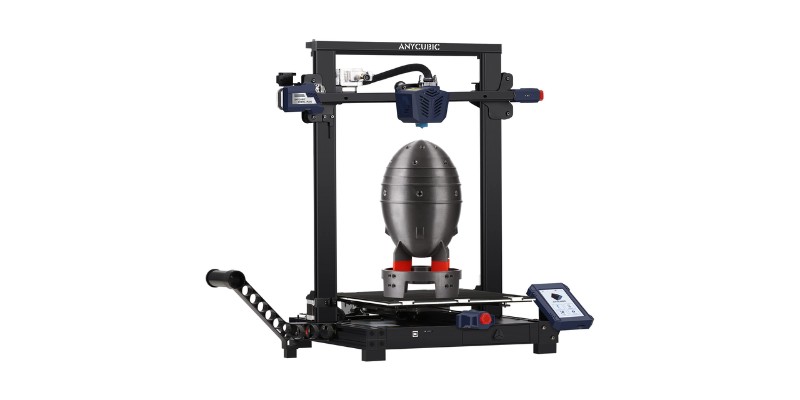
Anycubic has really spoiled their fanbase with budget, high volume printers. Both the Kobra Plus and the Kobra Max belong in this comparison despite being a hundred or so more than the other printers we covered.
The Kobra Plus has a build volume of 350 x 300 x 300 mm, whereas the Kobra Max has an even more impressive build volume of 400 x 400 x 450 mm. Aside from that, they’re very similar printers.
They both use a carborundum glass build plate, which has many of the same pros as a regular tempered glass plate. It has good temperature resistance and adhesion– although we must admit it isn’t as convenient to remove prints as with a flexible magnetic plate.
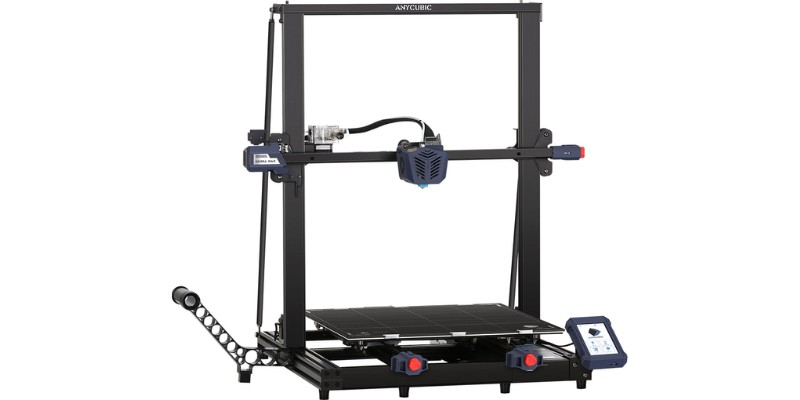
Continuing with the shared features, the Kobra Plus and Max have automatic bed-leveling and filament runout sensors. Unlike the other two printers, they have a color 4.3” touch screen. There’s even a pullout tool drawer on the Kobra Plus.
These Kobra printers may cost a bit more, but they haven’t expanded the number of filaments they’re compatible with. You’ll have the most luck with PLA, PETG, ABS, TPU, and Wood.
Regardless, you can be certain that Anycubic printers are reliable, budget friendly, and beginner friendly. Either the Kobra Plus or the Kobra Max is a solid pick if you’re craving extra build volume without sacrificing too much.
Comparison Showdown
Build Volume
| 3D Printer | Build Volume |
|---|---|
| Sovol SV03 | 350 x 350 x 400 mm |
| Ender 5 Plus | 350 x 350 x 400 mm |
| Anycubic Kobra Plus | 350 x 300 x 300 mm |
| Anycubic Kobra Max | 400 x 400 x 450 mm |
The Kobra Max is the biggest printer, with a build volume of 400 x 400 x 450 mm. The SV03 is surprisingly close at 350 x 350 x 400 mm, despite being $170 cheaper. Sadly, the Kobra Plus is lacking in both length and vertical space compared to the SV03.
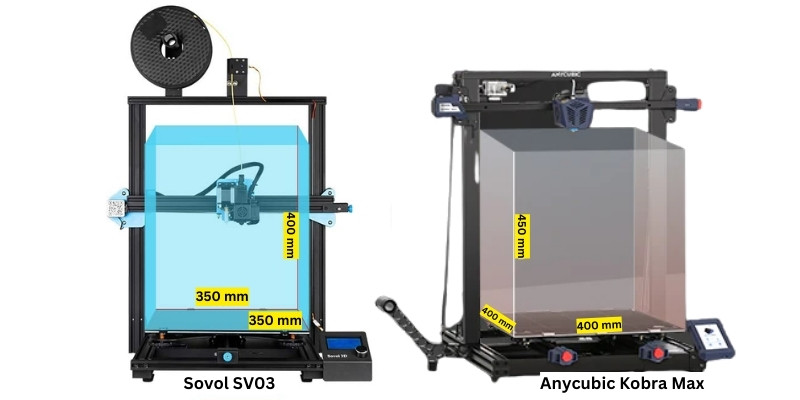
The Ender 5 Plus costs significantly more than the SV03, as the most expensive printer on the list. But when it comes to build volume, it settles for that middle range of 350 x 350 x 400 mm.
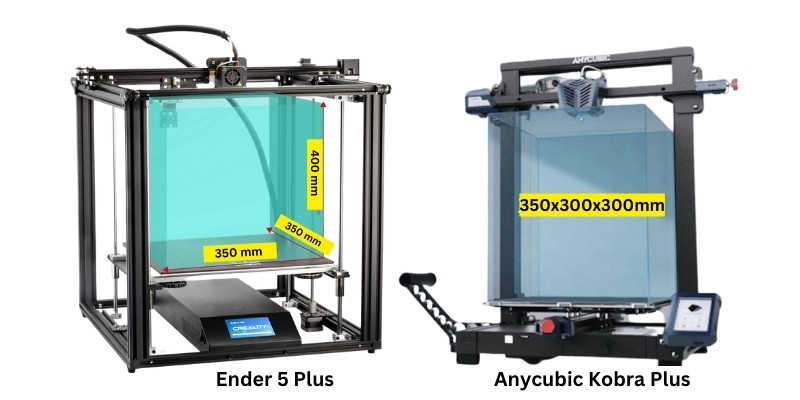
It’s difficult to put these measurements into perspective without considering what you actually want to print, so we’ll talk briefly about a few examples of large prints. We’ll also mention what you can do with smaller printers
Large landscape pieces like this fantasy castle are best served by the biggest printer possible. However, these types of pieces could also work with printers on the lower end of the spectrum like the Kobra Plus. You likely will be happy with the results from any of these printers.
Models and statuettes also come in a variety of different scales, but some scales will be completely inaccessible with the Kobra Plus because of the limited z-axis. For example, a 1:6 scale human model would be around 1 foot. It would easily fit in the SV03, Ender 5 Plus, and the Kobra Max.
Cosplay pieces are one of the main draws of a larger printer. Cosplay armor and even a two-part shield can be printed on the Kobra Max. You could technically get away with doing it on the SV03 or Ender 5 Plus, too– but it would be a tight fit. You’d be very restricted in what types of cosplay pieces you could print on a Kobra Plus.
Masks are a great idea for a cosplay piece that can work with a smaller build volume. The average length of a face is around 200 mm, which means all of the printers could make smaller face masks. The Kobra Plus would be cutting it close.
Noise Estimates
| 3D Printer | Board |
|---|---|
| Sovol SV03 | Creality V2.2.1 Silent Board |
| Ender 5 Plus | Creality V2.2 Non-silent Board |
| Anycubic Kobra Plus | Trigorilla (S010070) |
| Anycubic Kobra Max | Trigorilla (S010075) |
Accurate noise levels depend on a variety of factors, including (but not limited to) the location of the printer, the controller board, the fan, and so on. We’ll be largely basing our estimates for how noisy you can expect the printer to be on the motherboard and word of mouth.
To start with, the Sovol SV03 uses a Creality motherboard designed to be quieter. It’s certainly not the quietest it can be, but it’s generally going to be the quietest out of these printers.
The Ender 5 Plus uses a different Creality motherboard – this time, it’s non-silent. We found this to be somewhat disappointing, since the much cheaper Ender 5 Pro is actually equipped with a silent motherboard. Why not the 5 Plus?
Both the Kobra Max and the Kobra Plus are relatively quiet, around the same point as the Ender 5 Plus. The Kobra Max’s Trigorilla S010075 tends to be slightly quieter.
Extruder Type
| 3D Printer | Extruder Type |
|---|---|
| Sovol SV03 | Direct Drive |
| Ender 5 Plus | Bowden |
| Anycubic Kobra Plus | Bowden |
| Anycubic Kobra Max | Bowden |
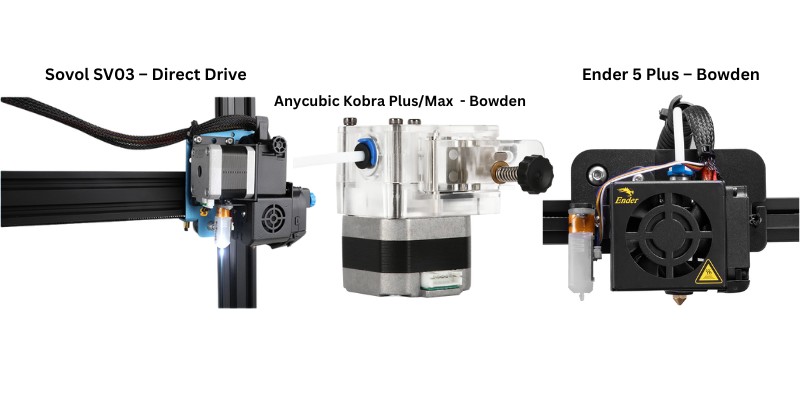
The SV03 is unique in this lineup for having a direct drive extruder. This type of extruder has been considered an upgrade in the past, but it does have some drawbacks when compared to Bowden extruders.
A Bowden extruder is mounted on the frame of the printer and then connected to the printhead via tubing. Direct drive extruders combine everything and pack it onto the printhead, which often prevents extrusion-related issues and makes it easier to work with finicky filaments like TPU.
That being said, Bowden extruders keep the printhead lighter, which can result in more accurate and faster prints. Direct drive extruders are still quick and accurate, though. The difference between the two is largely up to personal preference.
We usually recommend a direct drive extruder for the sake of reliability and simplicity. This is especially relevant if you’re new to 3D printing or you hate the troubleshooting process.
It’s possible to upgrade to a direct drive system. The hardware will cost around $40, but it’s not too difficult to set up with a guide.
Build Plate
| 3D Printer | Build Plate |
|---|---|
| Sovol SV03 | Tempered glass |
| Ender 5 Plus | Tempered glass |
| Anycubic Kobra Plus | Carborundum glass |
| Anycubic Kobra Max | Carborundum glass |
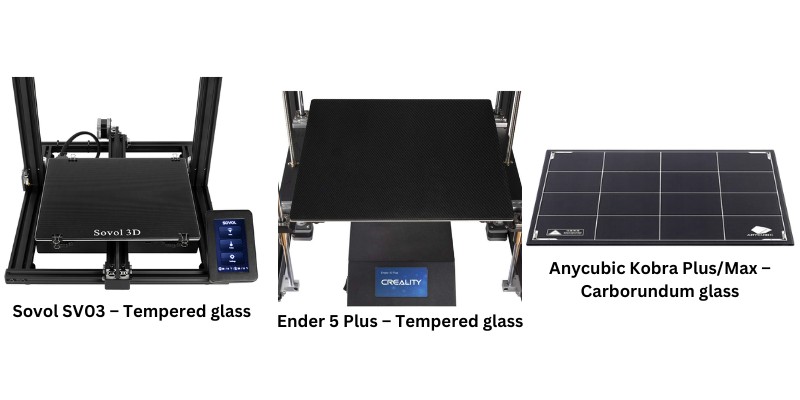
Let’s get this out of the way: as far as we can tell, the SV03/Ender 5 Plus’s tempered glass and the Kobra Plus/Max’s Carborundum glass perform about the same. They both have good temperature resistance and adhesion, and glass won’t wear down too quickly.
As far as build plates go, all of these printers are tied. It will be pretty easy to find upgrades regardless of which you choose, too.
Touch Screen
| 3D Printer | Touch Screen |
|---|---|
| Sovol SV03 | No |
| Ender 5 Plus | Yes |
| Anycubic Kobra Plus | Yes |
| Anycubic Kobra Max | Yes |
Only the Sovol SV03 doesn’t have a touch screen.
It could be enough to tip the scales away from the SV03 if you want your printer to feel more premium, although it doesn’t have a meaningful impact on functionality.
It’s also important to note that the SV03 is significantly cheaper than all of these other printers – the lack of a touch screen is no surprise.
Assembly
| 3D Printer | Assembly |
|---|---|
| Sovol SV03 | 5 to 30 minutes |
| Ender 5 Plus | 30 to 40 minutes |
| Anycubic Kobra Plus | 30 minutes |
| Anycubic Kobra Max | 30 minutes |
The assembly times of all of these printers are quite similar, and you can always go faster if you’ve done it before. Anycubic generally ships its printers (including the Kobra Plus and Max) mostly assembled. You only need to plug in some things and tighten screws, for the most part.
Although Creality is similar, the Ender 5 Plus is broken up into slightly more pieces which could increase the assembly time.
As for the SV03, it’s generally going to take around 30 minutes to put it together from the box. You can also buy it pre-assembled from some sites, but it’s easiest to just spend the short amount of time putting it together.
Price
| 3D Printer | Price |
|---|---|
| Sovol SV03 | $400 |
| Ender 5 Plus | $580 |
| Anycubic Kobra Plus | $500 |
| Anycubic Kobra Max | $570 |
Although the Ender 5 Plus’s $580 price tag is intimidating and pushes the boundaries of a budget printer, we included it here because it’s one of the printers people look to first for budget high-volume. Frankly, it’s not your best bet if your priority is the build volume.
The Kobra Max has the same cost-adding features like a filament runout sensor and auto bed-leveling. It’s $10 cheaper for significantly more space with more or less the same specs, and that’s hard to beat.
But we understand cost is (unfortunately) the deciding factor in many situations. The Sovol SV03 is a genuinely good option if you’re chasing a discount. Not only is it at least $100 cheaper than the next best on this list, but it keeps all of the most important features.
There’s not much of a cost analysis to do here when considering the SV03, since it’s so much cheaper and even has cost benefits. For example, anyone who wants a direct drive extruder will be happy that it comes “for free” as the default.
SV03 vs Ender 5 Plus vs Kobra Plus/Max – The Bottom Line
Everything considered, the SV03 is the most worthwhile large-volume discount printer. It’s great value, while still retaining helpful features.
Unfortunately, the Ender 5 Plus isn’t quite worth the price difference. The stable printing system (dual-axis motor and immovable bed) isn’t that much of an improvement over the SV03, nor is the addition of a touchscreen.
When it’s $180 more expensive than the SV03, we would expect some large differences. But the SV03 simply has more cost value than the Ender 5 Plus when all is said and done.
The Kobra Plus and the Kobra Max both have their place as more expensive options for even larger build volumes. We suggest going straight for the Kobra Max if you can afford it, since you get a noticeable build volume increase for $70 more.
There are few differences between the Kobra Plus and Max aside from the build volume, so that should be the deciding factor.
Other similar 3D printer comparisons:
